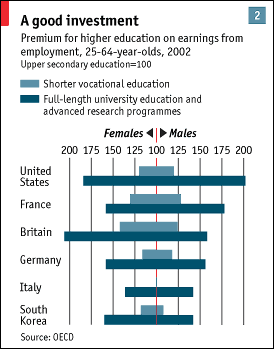"Bigger is Worse"
Kingsley Amis
“Better brain drain than brain in the drain."
Rajiv Gandhi
The Economist has a very good survey of higher education, reflecting of course its conservative economic views. Some excerpts are included below:
"Mass higher education is forcing universities to become more diverse, more global and much more competitive." The Brains Business
"America's system of higher education is the best in the world. That is because there is no system." Secrets of Success Competition rules, institutions are diverse, and all use diverse sources of finance. The model stresses knowledge creation, education, and service.
"The Institute of Higher Education at Shanghai's Jiao Tong University ranks the world's universities on a series of objective criteria such as the number of Nobel prizes and articles in prestigious journals. Seventeen of the top 20 universities in that list are American (see table in article); indeed, so are 35 of the top 50. American universities currently employ 70% of the world's Nobel prize-winners. They produce about 30% of the world's output of articles on science and engineering, according to a survey conducted in 2001, and 44% of the most frequently cited articles."
"Europe hopes to become the world's pre-eminent knowledge-based economy. Not likely!" (Head in the Clouds) The hand of government is too heavy for The Economist's taste.

Developing countries see the point of higher education. (A World of Opportunity)
"Public spending on universities in developing countries is highly regressive. In Latin America the professional classes, who account for 15% of the population, take up nearly half of all university places. In Rwanda, 15% of the total education budget is spent on the 0.2% of students who attend universities. Most universities in the developing world are also hopelessly badly managed. But there are a few bright spots on the horizon."
"India has two valuable things going for it. One is its collection of elite institutions. For decades, India has been pouring resources into the All India Institute of Medical Sciences, the Indian Institute of Science in Bangalore and, above all, the Indian Institutes of Technology. These institutions take their pick from an army of candidates every year, with 180,000 hopefuls taking the screening test for around 3,500 places in the seven IITs. They provide a highly intensive education, with all students and often professors too living on campus. And they produce a stream of highly educated people who help to set professional standards. “They are a class apart, like Oxford and Cambridge,” says P.V. Indiresan, an expert on universities. These elite institutions help to keep India plugged into the global knowledge economy.........India's other big advantage is a more recent development: a booming private sector."
"In higher education, as in so much else, China is visibly pulling ahead of India. The Chinese are engaged in the biggest university expansion in history. In the 1980s, only 2-3% of school-leavers went to university. In 2003, the figure was 17%. The watershed year was 1999, when the number of students enrolled jumped by almost half. The expansion at the doctoral level is even faster than for undergraduates: in 1999-2003, nearly 12 times as many doctorates were awarded as in 1982-89 (see chart 4). And there is more to come: the number of new doctoral students jumped from 14,500 in 1998 to 48,700 in 2003. The Chinese are determined to create a super-league of universities to rival the best in the world."
For students, higher education is becoming a borderless world. (Wandering Scholars)
"For the past 50 years America has effortlessly dominated the market for international students, who have brought both direct and indirect benefits. Not only are they contributing some $13 billion a year to America's GDP, they are also supplying brainpower for its research machine and energy for its entrepreneurial economy. But now America's leadership is under challenge. The Institute of International Education reports that the number of foreign students on American campuses declined by 2.4% in 2003-04, the first time the number has gone down in 30 years. Foreign applications to American graduate schools fell by 28% last year, and actual enrolment dropped by 6%." While the demand for international education is growing, the competition for students from other developed nations is increasing, and the Bush Administration's policies have made it more difficult to foreign students to get into the United States.
Universities have become much more businesslike, but they are still doing the same old things. (Higher Ed Inc)
"The University of Phoenix is America's largest for-profit university (and indeed America's largest university, full stop), with 280,000 students, 239 campuses and various offshoots around the world, including some in China and India.....The University of Phoenix is designed to cater for the needs of working adults, who make up 95% of its students. The emphasis is on practical subjects, such as business and technology, that will help them with their careers, and on fitting in with busy schedules......in designing a university for working adults, Mr Sperling also introduced two other far-reaching innovations. The first was to concentrate power in the organisation. In traditional universities academics are semi-independent contractors who devote as much time as possible to their own research. In Phoenix they are simply employees. It is the university, not the teachers, that owns the curriculum. Todd Nelson, the company's boss, claims that this has allowed the university to become a “learning organisation”: it is constantly improving its ability to teach by measuring performance and disseminating successful techniques. The only research it cares about is the sort that improves teaching. The second innovation is to turn higher education into a business." The University also emphasizes distance education.
There is an audio streaming interview with the author.
And a nice set of links for sources.